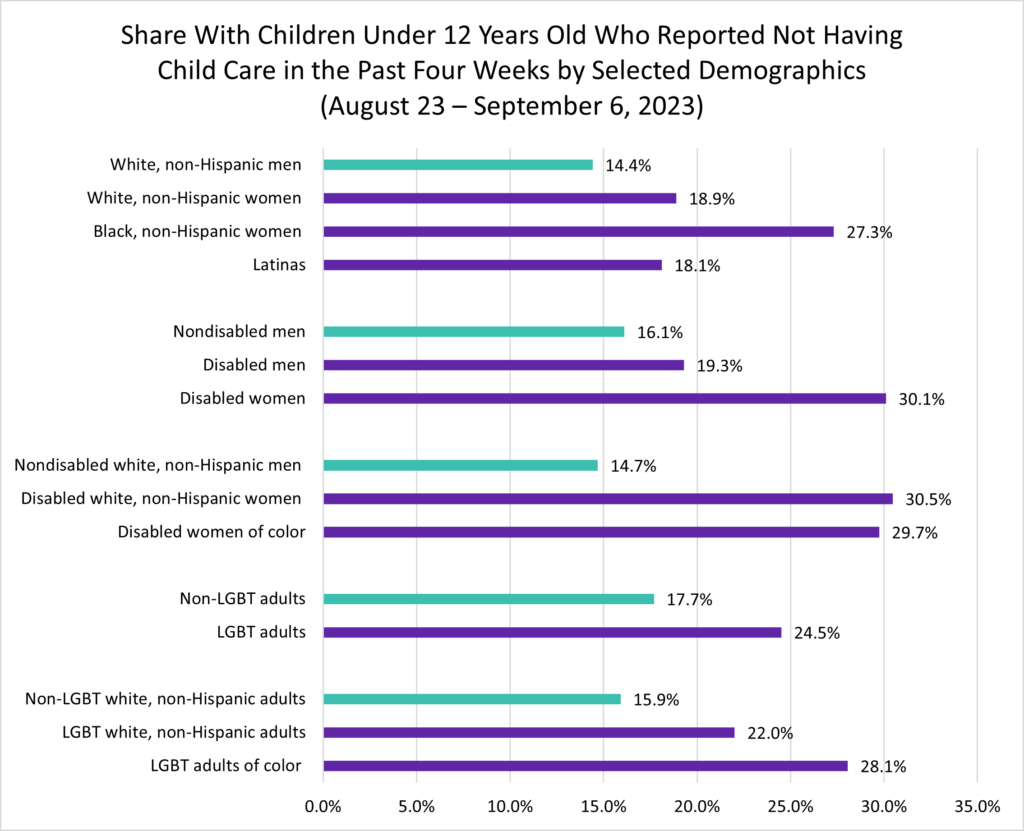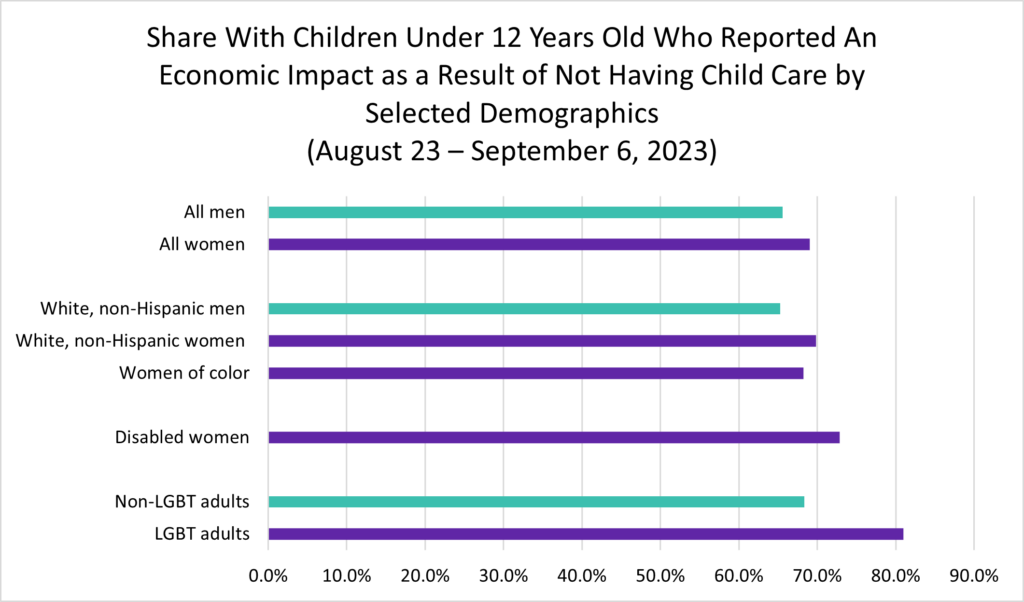High Shares of Women with Children Under 12 Lack Access to Child Care As the Child Care Funding Cliff Approaches
NWLC analysis of the latest round of the Census Bureau’s Household Pulse Survey shows that among those with children under 12 years old in the household:
One in five (20.2%) women reported that, at some point in the last four weeks, children in their household were unable to attend child care as a result of child care being closed, unavailable, unaffordable, or because they were concerned about their child’s safety. In comparison, 16.4% of men reported the same. Black, non-Hispanic women (27.3%) were nearly two times more likely than white, non-Hispanic men (14.4%) to report their children could not attend child care. Black, non-Hispanic women were also more likely than white, non-Hispanic women (18.9%) to report not having child care. In addition, 18.1% of Latinas reported the same.
Disabled women (30.1%) were disproportionately likely to report their children were unable to attend child care at some point in the past four weeks. Disabled women were nearly two times more likely than nondisabled men (16.1%) and were also more likely than disabled men (19.3%) to report their children could not attend child care. Nearly three in ten disabled women of color (29.7%) and over three in ten white, non-Hispanic disabled women (30.5%) reported not having child care. They were both two times more likely that nondisabled white, non-Hispanic men (14.7%) to report so.
Nearly one in four LGBT adults (24.5%) reported their children were unable to attend child care at some point in the past four weeks, and they were more likely than non-LGBT adults (17.7%) to report this. LGBT adults of color (28.1%) were nearly two times more likely than non-LGBT white, non-Hispanic adults (15.9%) to report not having child care. In addition, 22.0% of LGBT white, non-Hispanic adults reported their children were unable to attend child care.
Click here for a summary of the findings.

Source: NWLC calculations based on August 23—September 6, 2023, Week 61 of the U.S. Census Bureau Household Pulse Survey. U.S. Census Bureau, “Measuring Household Experiences During the Coronavirus (COVID-19) Pandemic, 2020-2023 Household Pulse Survey,” https://www.census.gov/data/experimental-data-products/household-pulse-survey.html, accessed September 20th, 2023.
The Household Pulse Survey asked all respondents whether children in the household were not attending child care due to child care being closed, unavailable, unaffordable, or because parents were concerned about the child’s safety in the past four weeks. This analysis is restricted to respondents with children under 12 years old in the household. Survey respondents self-identified as male or female, their race, whether they were of Hispanic, Latino, or Spanish origin, and if they had a disability via six questions. Calculations for Asian, non-Hispanic women are not included due to insufficient sample sizes.
Economic Impact
Not having child care greatly harms women’s employment participation and economic security. Among those who did not have child care for children under 12 years old:
Nearly seven in ten (69.0%) women experienced an economic impact, such as being forced to take unpaid leave, cut their work hours, leave their jobs, lose their job, or not look for a job, because they did not have child care. In comparison, 65.6% of men reported economic impacts. 69.9% of white, non-Hispanic women, 67.2% of Black, non-Hispanic women, and 68.2% of all women of color experienced an economic impact. Additionally, 65.3% of white, non-Hispanic men reported the same.
Over seven in ten disabled women (72.9%) reported having to take unpaid leave, cut their work hours, leave their jobs, lose their jobs, or did not look for a job because they did not have child care. Over four in five LGBT adults (81.0%) reported an economic impact due to a lack of child care and were more likely than non-LGBT adults (68.4%) to report so.

Source: NWLC calculations based on August 23—September 6, 2023, Week 61 of the U.S. Census Bureau Household Pulse Survey. U.S. Census Bureau, “Measuring Household Experiences During the Coronavirus (COVID-19) Pandemic, 2020-2023 Household Pulse Survey,” https://www.census.gov/data/experimental-data-products/household-pulse-survey.html, accessed September 20th, 2023.
This analysis is restricted to respondents with children under 12 years old in the household who reported an economic impact–including being forced to take unpaid leave, cutting their work hours, leaving their jobs, losing their job, or not looking for a job–due to not having child care. Survey respondents self-identified as male or female, their race, whether they were of Hispanic, Latino, or Spanish origin, and if they had a disability via six questions. Calculations for Asian, non-Hispanic women are not included due to insufficient sample sizes.
This analysis was conducted by Sarah Javaid at the National Women’s Law Center. Please contact [email protected] for questions.




